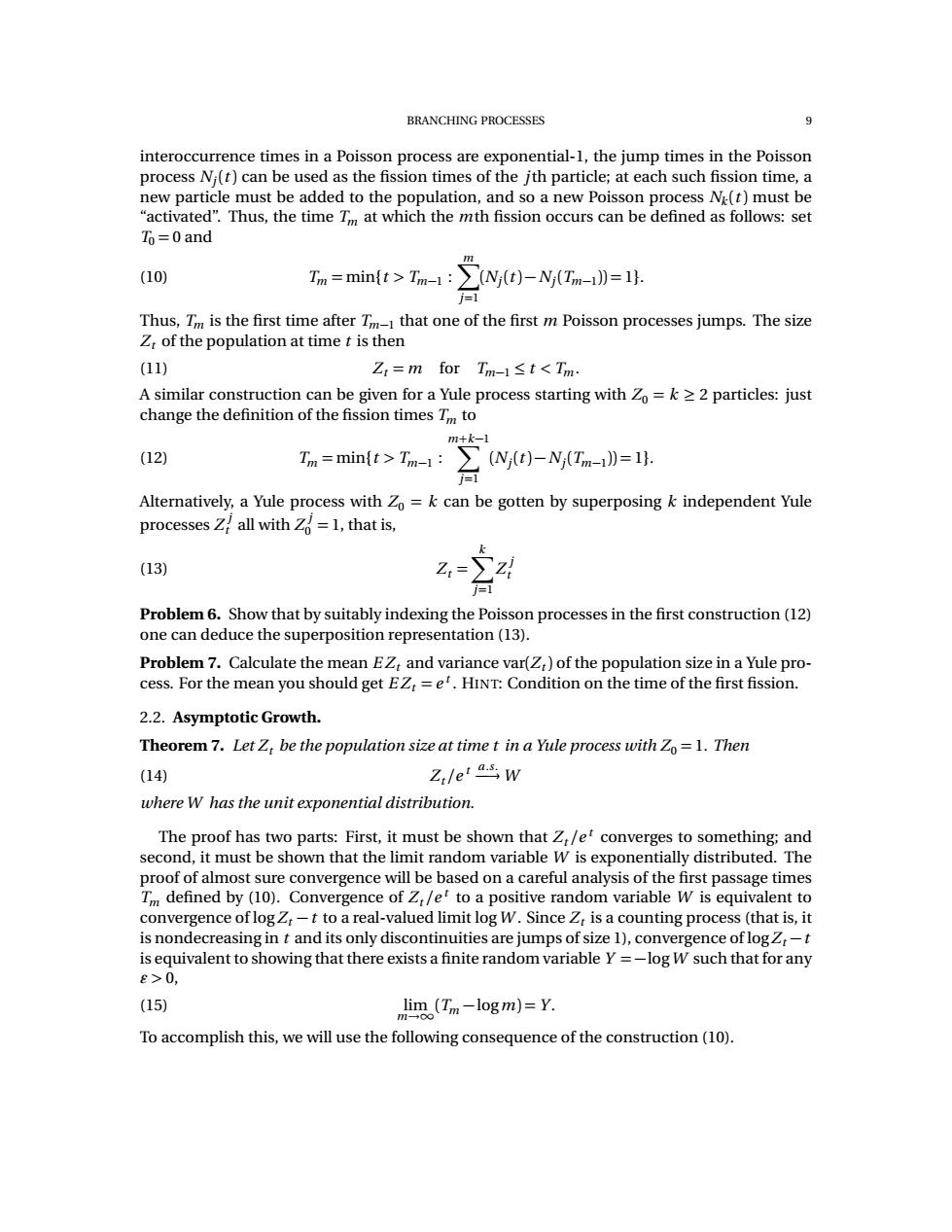正在加载图片...

BRANCHING PROCESSES 9 interoccurrence times in a Poisson process are exponential-1,the jump times in the Poisson process Ni(t)can be used as the fission times of the jth particle;at each such fission time,a new particle must be added to the population,and so a new Poisson process N(t)must be "activated".Thus,the time Tm at which the mth fission occurs can be defined as follows:set To=0 and (10) Tm=min{t>Tm-1: N(t)-N(Tm-)=1} =1 Thus,Tm is the first time after Tm-1 that one of the first m Poisson processes jumps.The size Zt of the population at time t is then (11) Z,=m for Tm-1≤t<Tm A similar construction can be given for a Yule process starting with Zo=k>2 particles:just change the definition of the fission times Tm to m+k-1 (12) Tm=min{t>Tm-1:∑(Wy(t)-N,(Tm-》=1. j=1 Alternatively,a Yule process with Zo =k can be gotten by superposing k independent Yule processesZ all with=1,that is, (13) Z=L Problem 6.Show that by suitably indexing the Poisson processes in the first construction(12) one can deduce the superposition representation(13). Problem 7.Calculate the mean EZt and variance var(Zt)of the population size in a Yule pro- cess.For the mean you should get EZ,=e'.HINT:Condition on the time of the first fission. 2.2.Asymptotic Growth. Theorem 7.Let Z,be the population size at time t in a Yule process with Zo=1.Then (14) Zrle!asw where W has the unit exponential distribution. The proof has two parts:First,it must be shown that Z/et converges to something;and second,it must be shown that the limit random variable W is exponentially distributed.The proof of almost sure convergence will be based on a careful analysis of the first passage times Tm defined by (10).Convergence of Z/et to a positive random variable W is equivalent to convergence of log Z:-t to a real-valued limit log W.Since Zt is a counting process(that is,it is nondecreasing in t and its only discontinuities are jumps of size 1),convergence oflog Z-t is equivalent to showing that there exists a finite random variable Y =-log W such that for any e>0, (15) lim(Tm-logm)=Y. 71+●0 To accomplish this,we will use the following consequence of the construction(10).BRANCHING PROCESSES 9 interoccurrence times in a Poisson process are exponential-1, the jump times in the Poisson process Nj (t ) can be used as the fission times of the jth particle; at each such fission time, a new particle must be added to the population, and so a new Poisson process Nk (t ) must be “activated”. Thus, the time Tm at which the mth fission occurs can be defined as follows: set T0 = 0 and (10) Tm = min{t > Tm−1 : Xm j =1 (Nj (t ) −Nj (Tm−1 )) = 1}. Thus, Tm is the first time after Tm−1 that one of the first m Poisson processes jumps. The size Zt of the population at time t is then (11) Zt = m for Tm−1 ≤ t < Tm . A similar construction can be given for a Yule process starting with Z0 = k ≥ 2 particles: just change the definition of the fission times Tm to (12) Tm = min{t > Tm−1 : mX +k−1 j =1 (Nj (t ) −Nj (Tm−1 )) = 1}. Alternatively, a Yule process with Z0 = k can be gotten by superposing k independent Yule processes Z j t all with Z j 0 = 1, that is, (13) Zt = X k j =1 Z j t Problem 6. Show that by suitably indexing the Poisson processes in the first construction (12) one can deduce the superposition representation (13). Problem 7. Calculate the mean E Zt and variance var(Zt ) of the population size in a Yule process. For the mean you should get E Zt = e t . HINT: Condition on the time of the first fission. 2.2. Asymptotic Growth. Theorem 7. Let Zt be the population size at time t in a Yule process with Z0 = 1. Then (14) Zt /e t a.s. −→ W where W has the unit exponential distribution. The proof has two parts: First, it must be shown that Zt /e t converges to something; and second, it must be shown that the limit random variable W is exponentially distributed. The proof of almost sure convergence will be based on a careful analysis of the first passage times Tm defined by (10). Convergence of Zt /e t to a positive random variable W is equivalent to convergence of logZt − t to a real-valued limit logW . Since Zt is a counting process (that is, it is nondecreasing in t and its only discontinuities are jumps of size 1), convergence of logZt −t is equivalent to showing that there exists a finite random variable Y = −logW such that for any " > 0, (15) limm→∞ (Tm − logm) = Y . To accomplish this, we will use the following consequence of the construction (10)